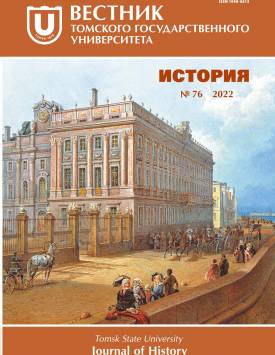The evolution of labour migration regulation in Eurasia in the XX-XXI centuries
The article provides the overview of the changes in labour migration regulation in the Russian Empire, the Soviet Union and the post-Soviet area throughout several centuries. The labour migration role for the development of the Eurasian migration system development is described in the article with the history of the region taken into consideration. The Eurasian migration system is considered to be the set of stable migration flows of various types, established due to historical, cultural, economic, social and other ties between the countries of the post-Soviet area. Thus, the research is mainly based on the migration systems theory. However, historical ties as well as objectively existing differences in the levels of economic development between the countries of departure and destination of migrants in the post-Soviet area are now supplemented by political decisions influencing migration flows, too. Therefore, the author aims at analyzing both the objective prerequisites and nowadays political framework of migration in the post-Soviet area in order to detect their influence on the reasons, directions and scope of current migrations in the region considered in the article. The Commonwealth of Independent States (CIS) that was established at the post-Soviet area just after the collapse of the Soviet Union, created the conditions for visa-free movement of labor migrants in the 1990s, however, without exempting them from other obligations for legal employment in Russia. It provided the CIS states citizens with advantages over other labour migrants at the Russian labour market. Since the Eurasian Economic Union (EEU) has been launched in 2015 and the single labour market has been created there, the citizens of its five member-states have enjoyed the equal treatment with locals at Russian labour market. The creation of the EEU resulted into less favorable conditions at Russian labour market for those labour migrants who are the citizens of the CIS states not participating in the EEU. The author takes the example of migration between Ukraine, Moldova and Russia in the XX-beginning of XXI centuries to show that despite the prerequisites for large labour migration in the post-Soviet area, the existence of 'two-speed' Eurasian economic integration influences the priority destinations of labour migrants from some CIS countries that are not the EEU member-states. Thus, labour migration of the Ukrainian and Moldavian citizens has switched from Russia to the European Union.
Keywords
international labour migration,
regional economic integration,
the Eurasian Economic Union,
Russian labour market,
Ukrainian labour migrants Moldavian labour migrantsAuthors
| Pogorelskaya Anastasia M. | Tomsk State University | lisbonne@rambler.ru |
Всего: 1
References
International Migration Report // United Nations. 2017. URL: http://www.un.org/en/development/desa/population/migration/publications/migrationreport/docs/MigrationReport2017_Highlights.pdf (accessed: 15.12.2018)
Концепция государственной миграционной политики Российской Федерации на 2019-2025 годы URL: http://kremlin.ru/events/president/news/58986 (дата обращения: 17.08.2019).
Концепция 2007 - Концепция демографической политики Российской Федерации на период до 2025 года // Население и общество. 2007 URL: http://www.demoscope.ru/weekly/knigi/koncepciya/koncepciya25.html (дата обращения: 14.08.2019).
Гаврилова Н.Ю., Дудин В.Е., Устинова О.В. Миграционная политика в дореволюционной России // Гуманитарные, социально-экономические и общественные науки, 2018. № 3. С. 1-7.
Воробьева О.Д., Рыбаковский Л.Л., Рыбаковский О.Л. Миграционная политика России: история и современность. М. : Экон-Информ, 2016. 192 с.
Максудов С. Миграции в СССР в 1926-1939 годах // Cahiers du monde russe : Russie, Empire russe, Union sovietique, Etats independants. 1999. Вып. 40 (4). С. 763-796.
Никулин П.Ф. Основные направления и итоги Столыпинской аграрной реформы (1906-1916 гг.) // Вестник Томского государственного уни верситета. История. 2012. №» 1 (17). С. 5-10.
Зайончковская Ж.А. Миграция населения СССР и России в XX веке: эволюция сквозь катаклизмы // Проблемы прогнозирования. 2000. № 4. С 3-15.
Жирнов Е. «Не имеют права на паспорт 37 процентов граждан» // Коммерсантъ Власть. 2009. № 14. С. 54.
Тарасов А.Ю. Паспортная система и паспортный режим в Советском государстве в 30-е гг. XX в. : автореф. дис.. канд. юрид. наук. М., 2005. 25 с.
Васильева Э.К., Елисеева И.И., Кашина О.Н. и др. Динамика населения СССР 1960-1980 гг. М. : Финансы и статистика, 1985. 176 с.
Сталинские депортации. 1928-1953 / под общ. ред. А.Н. Яковлева; сост. Н.П. Поболь, П.М. Полян. М. : Междунар. фонд «Демократия» : Материк, 2005. 902 с.
Конохова А.С. «И нам в ответ раздаются назначения по городам областного значения..»: система распределения выпускников вузов в СССР в годы хрущевской «оттепели» // Новейшая история России. 2012. № 3. С. 233-242.
Ивахнюк И.В. Евразийская миграционная система: теория и политика // Вестник РУДН. Сер. Международные отношения. 2008. № 2. С. 21-28.
Юдина Т.Н. Социология миграции: к формированию нового научного направления. М. : Дашков и К°, 2004. 399 с.
Ивахнюк И.В. Формирование и функционирование Евразийской миграционной системы : автореф. дис.. д-ра экон. наук. М., 2008. 46 с.
Monthly earnings // International Labour Organization. 2019. URL:https://www.ilo.org/ilostat/faces/wcnav_defaultSelection;ILOSTATCOOKIE=aqgoBm2ben8fRNspgOzdP95MiPoHpHJK2v9-rc8-FZYNCsWLH_xe!-612270756?_afrLoop=5046035024253684&_afrWindowMode=0&_afr WindowId=null#!%40%40%3F_afrWindowId%3Dnull%26_afiLoop%3D5046035024253684%26_afrWindowMode%3D0%26_adf.ctrlstate%3Dn9dx7f8u4_4 (accessed: 13.09.2019).
Сведения о численности граждан государств - членов Евразийского экономического союза, въехавших в страну для осуществления трудовой деятельности за 2013 - 1 полугодие 2019 г. // Евразийская экономическая комиссия. 2018. URL: http://www.eurasiancommission.org/ru/act/finpol/migration/tm/Documents/Сведения%20о%20численности%20граждан%20государств%202013-%201%20полугодие%202019.pdf (дата обращения: 28.08.2019).
Отдельные показатели миграционной ситуации в Российской Федерации за январь - декабрь 2018 года с распределением по странам и регионам // Министерство внутренних дел Российской Федерации. 2019. 24 янв. URL: https://xn--b1aew.xn--p1ai/Deljatelnost/statistics/migracionnaya/item/15851053/(дата обращения: 15.09.2019).
Узбекистан прорабатывает вопрос о присоединении к ЕАЭС, - заявила Матвиенко // РИА Новости. 2019. 2 окт. URL: https://ria.ru/20191002/1559343154.html (дата обращения: 12.010.2019).
Международная миграция // Федеральная служба государственной статистики. 2019. 4 июня. URL: https://gks.ru>storage>mediabank>Migr2 (дата обращения: 13.10.2019).
The contribution of human resources development to migration policy in Moldova // European Training Foundation. 2007. December. URL: https://www.etf.europa.eu/sites/default/files/rn/C12578310056925BC12573DB004D3B74_NOTE84CGJU.pdf (accessed: 12.10.2019).
Emigrants and immigrants based on border crossing data, by sex and age group, 2014-2017 // National Bureau of Statistics, Moldova. 2018. URL: http://statbank.statistica.md/pxweb/pxweb/en/20%20Populatia%20si%20procesele%20demografice/20%20Populatia%20si%20procesele%20demografice_POPrec_POP070/POP070100rcl.px/table/tableViewLayout1/?rxid=b2if27d7-0b96-43c9-934b-42e1a2a9a774 (дата обращения: 12.10.2019).
Migration and migrant population statistics // Eurostat. 2018. URL: https://ec.europa.eu/eurostat/statistics-explained/index.php?title=Migration_and _migrant_population_statistics (accessed: 13.10.2019).
Annual Remittances Data : updated as of Apr. 2019 // The World Bank Group. 2019. URL: https://www.worldbank.org/en/topic/migrationremittancesdiasporaissues/brief/migration-remittances-data (accessed: 12.10.2019).

